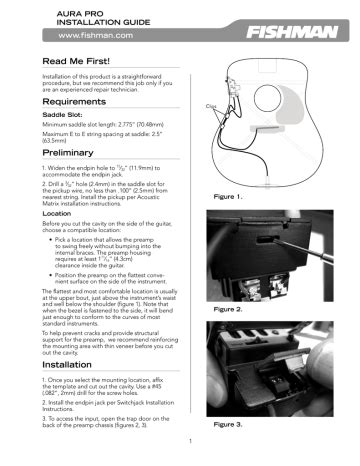Fishman Aura Pro: Installation with Professional Tips
The Fishman Aura Pro is a highly sought-after acoustic guitar pickup system renowned for its exceptional sound quality and versatility. However, achieving the best possible sound from this system relies heavily on proper installation. This guide provides a detailed walkthrough of the Aura Pro installation process, incorporating professional tips to ensure a flawless and optimal setup. We'll also address common questions surrounding installation and troubleshooting.
What You'll Need for Aura Pro Installation
Before beginning, gather the necessary tools and materials:
- Fishman Aura Pro System: This includes the soundboard transducer, the preamp unit, the endpin jack, and all accompanying hardware.
- Phillips head screwdriver: Choose a size that fits your screws snugly.
- Small flathead screwdriver: Useful for gently prying and adjusting components.
- Drill with small drill bits: May be needed for pilot holes, depending on your guitar's construction.
- Soldering iron and solder: If you need to modify existing wiring. This is less common but possible with some guitar models.
- Multimeter: To test wiring continuity and avoid short circuits.
- Wire strippers and cutters: Essential for precise wire preparation.
- Electrical tape: Securely insulate any connections.
- Wood glue (optional): Provides additional security for mounting components.
- Guitar cleaning cloth: Keep your instrument clean during the process.
- Patience and a steady hand: Precision is key for a successful installation.
Step-by-Step Aura Pro Installation Guide
1. Preparing the Guitar:
- Carefully inspect your guitar for any existing wiring or pre-installed pickup systems. Note their locations to avoid interference.
- Clean the guitar's surface with a soft, clean cloth. Remove any dust or debris that could interfere with adhesive.
2. Installing the Soundboard Transducer:
- Finding the Sweet Spot: The transducer’s placement is critical. Fishman typically provides guidelines, but experiment slightly for optimal sound. Many find the best location to be just below the soundhole.
- Securing the Transducer: Carefully adhere the transducer according to the manufacturer's instructions. Use gentle pressure to ensure proper adhesion. Avoid excessive pressure that could damage the finish.
3. Installing the Preamp Unit:
- Location Selection: The preamp's location is a matter of personal preference and depends on your guitar's design. Common choices include inside the soundhole (if space allows) or within the guitar body, requiring a small cavity.
- Mounting the Preamp: If mounting inside the soundhole, use double-sided tape provided, ensuring a firm and secure fit. If installing inside the guitar body, you'll likely need to create a small recess (carefully and professionally!).
4. Installing the Endpin Jack:
- Choosing the Right Jack: Select the appropriate endpin jack for your guitar’s construction. Some guitars may require a slight modification of the existing endpin hole for a perfect fit.
- Installing the Jack: Carefully install the endpin jack, ensuring a tight and secure connection.
5. Wiring the Components:
- Following the Diagram: Fishman provides detailed wiring diagrams. Adhere strictly to these instructions, paying close attention to color-coding and polarity. Improper wiring can lead to no sound or damage to your electronics.
- Soldering (if needed): If modifying existing wiring or installing in a location requiring soldered connections, use a low-wattage soldering iron and apply solder cleanly and precisely.
6. Testing the System:
- Check for Functionality: Once all components are installed and wired, plug in your guitar and test the system. Ensure you have sound from all controls and that there are no unexpected noises or feedback.
7. Final Adjustments:
- Fine-tuning: Once operational, adjust the preamp's tone controls to fine-tune the sound to your preference. Experiment with different settings to find the best sound for your guitar and playing style.
Troubleshooting Common Aura Pro Installation Issues
H2: Why is my Aura Pro not working?
Check all wiring connections, ensuring they are clean and secure. Verify the battery is correctly installed and has sufficient charge. Use a multimeter to test continuity in the wiring to identify any breaks.
H2: I'm getting feedback from my Aura Pro. How can I fix this?
Feedback is often caused by improper placement of components or excessive gain. Try adjusting the preamp's gain and tone controls. Experiment with the transducer's location, making sure it's not positioned too close to other components or metal parts of the guitar.
H2: My Aura Pro sounds muddy or thin. What can I do?
Experiment with the preamp's tone controls and the transducer's placement. Sometimes a small adjustment in location can significantly improve the sound. Consult Fishman's support or a professional guitar technician for further assistance.
H2: Is it difficult to install the Fishman Aura Pro myself?
The difficulty varies depending on your technical skills and the guitar's construction. While the process is achievable for DIY enthusiasts with some experience, opting for a professional installation from a qualified guitar technician guarantees optimal results and avoids potential damage to your instrument.
This comprehensive guide provides a solid foundation for a successful Fishman Aura Pro installation. Remember that precision and patience are key. If you encounter any difficulties, consult a qualified guitar technician—your guitar's sound quality and integrity are worth protecting!

